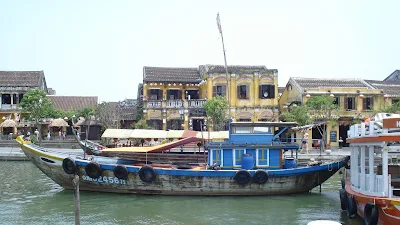 |
| On the Reunification Express |
Our train was the Reunification Express, and
we had an upper and a lower berth in a 4-berth “sharing” cabin.
Basically, we had the whole cabin to
ourselves, except for a brief time where a couple of men came in and slept
until their stop.
However, after initial misgivings about strange men in our
carriage, we felt safe.
Unfortunately, sleep did not come easily. The
sheets and pillows supplied were not clean and fresh, as with the overnight
train we used in Thailand.
Luckily, we had our sleeping bag liners that we
used. But we were not very relaxed.
In daylight, the scenery was great, with
stunning coastline on one side and exotic jungle on the other.
At about 11.45 am the next day, we got off the train in Da Nang,
Vietnam’s 3rd largest city (over 1 mil people).
 |
| Dragon Bridge, Da Nang |
Our first stop was beautiful Non Nuoc or China
Beach, made famous outside Vietnam, when US soldiers were sent there for R
& R during the war.
We then popped in to Marble Mountain, full of
grottos and caves. We also crossed the amazing Dragon Bridge.
 |
| Traditional Hoi An building (UNESCO) |
The bridge was designed and built in the shape
of a dragon, and to breathe fire and water each Saturday and Sunday night at
9:00 pm – which unfortunately we didn’t see.
Leaving Da Nang, we drove for about 40 minutes to
Hoi An, our destination for the next few days.
 |
| Traditional Hoi An building (UNESCO) |
Hoi An has an old town that is a UNESCO World
Heritage site.
It’s full of architectural interest, culture and heritage.
We arrived at our accommodation, dropped our
bags, and headed out to walk around this beautiful old city.
As we walked, we visited ancient merchant
houses, including the 200-year old Tan Ky family house.
 |
| People watching |
We saw the Fujian temple, the temple of the
water genie, Chua Ong Pagoda, and the Chinese Assembly Hall.
All painted a
yellow colour and all very interesting.
We walked around the attractive shops, then
visited more historic places.
Then we spotted a tailor. Leigh needed a short-sleeved shirt so we selected some material and she was measured up.
After a while, we stopped for a mocktail in a
local waterfront bar, and watched the many people and activities nearby.
Hoi An is situated on the Thu Bon River, which
acts as the main waterway for the town.
The town was a port in the 16th century, and
the old centre still sits on the water and is full of winding lanes, Chinese style shops, and narrow
canals.
 |
| Fisherman near Cua Dai village |
Everything from fishing boats, rice boats, and
of course, passenger boats.
The river is also used for everything from
washing food, dishes and clothes, to washing bodies.
Later, feeling energetic, we borrowed bicycles
from our hotel and rode to Cua Dai beach, about 5 km away on the East
China Sea.
The beach had recently been hit by a cyclone
and there were sandbags along the shoreline to help stop erosion from the high
sea.
These sandbags were also there to protect the giant nipa palms on the beach (called 'water coconut'
palms). The poor beach looked rather sad so we hoped it would recover soon.
Peddling back, we passed many small houses, waterways with men fishing, and people tending their fields.
Returning to Hoi An, one of our stops was
the beautiful Japanese Bridge.
It was built in the 1590's by the Japanese
community to link it with the Chinese quarters, and is a lovely piece of
Japanese architecture.
 |
| Hoi An market-preparing the catch for sale |
After picking up Leigh’s new shirt, which looked great, we then headed to the markets.
We had already been to the night market which was very lively, but the day-time market was so interesting.
It sells absolutely everything that you could imagine.
Our favourite part was the fish market, with the women sorting and preparing the day’s catch, ready for sale.
The next day, we had an outing to My Son, a
UNESCO World Heritage site.
My Son is a group of Hindu temple ruins.
 |
| My Son temple ruin (UNESCO) |
It is apparently the longest inhabited
archaeological site in Indochina.
Sadly, a huge portion of it was destroyed by
US bombers during a single week of the American War.
Most of the temples were made of red brick
with carvings cut directly into the brickwork, and no mortar was used between
the bricks. We read that this is quite a unique style of construction.
We finished the My Son trip with a boat ride
on the Thu Bon River. This included a delicious Vietnamese lunch and
plenty of sightseeing along the riverside.
We really loved Hoi An, the heritage, the
food, the colour, and the people. But it was time to move on.
Early the next morning, we boarded a Vietjet
plane – next stop Saigon. We are looking forward to seeing if this southern city is different to those further north.


